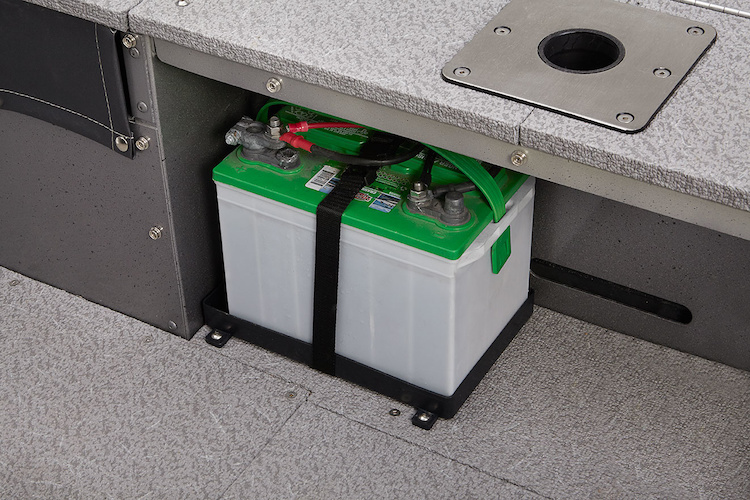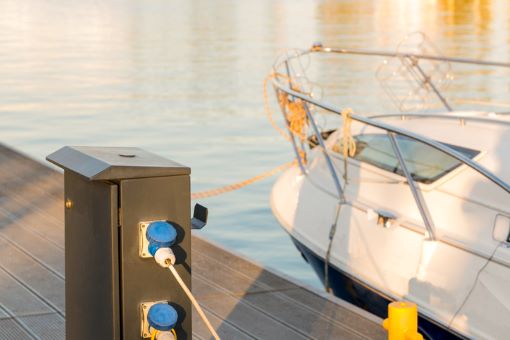Whether you're a seasoned boater or planning your maiden voyage, understanding your marine battery is essential to boating. A reliable marine battery is the heart of your boat's electrical system, providing the power you need to start the engine, run electronics, and keep everything functioning while you're on the water.
What Is A Marine Battery?
Marine batteries are specially designed to handle the unique challenges of the marine environment. They power everything from your boat's engine to electronics and accessories.
There are three main types of marine batteries, each serving a different purpose:
Starting (Cranking) Batteries
These deliver quick bursts of energy to start the boat's engine. They are not designed for extended, continuous use.
Marine Deep-Cycle Batteries
A deep-cycle battery is built to provide consistent power over a long period, and it is ideal for running electronics, trolling motors, and appliances.
Dual-Purpose Batteries
As the name suggests, dual-purpose batteries combine the cranking power of a starting battery with the deep-cycle capability, though they are less efficient than specialized batteries.

Deep-Cycle vs. Cranking Batteries: What's the Difference?
A common point of confusion is the difference between deep-cycle and cranking batteries.
Cranking (Starting) Batteries are designed to quickly deliver a large amount of power to start your engine. Once the engine runs, the alternator takes over, and the battery isn't needed for long-term power.
Deep-Cycle Batteries are engineered for steady, sustained energy output, which is ideal for electronics like fish finders, GPS systems, and onboard appliances that require a continuous power supply over long periods.
If your boat requires both functions, consider a dual-purpose battery, although it won't perform each task as well as the specialized versions.
Read Next: How to Winterize Your Boat
How to Choose the Right Marine Battery for Your Needs
Choosing the right battery depends on your boat's requirements and how you use it. Here are a few factors to consider:
- Boat Size and Power Needs: A small boat with minimal electronics will have different power needs than a large vessel with sophisticated systems.
- Battery Types: If your boat demands high bursts of power for starting and long periods of power for running electronics, you may need separate starting and deep-cycle batteries or a dual-purpose battery.
- Reserve Capacity: Look for a battery with enough reserve capacity (RC) to power your systems if your alternator fails. RC measures how long a battery can provide 25 amps of power before dropping below 10.5 volts.
- Cold Cranking Amps (CCA) and Marine Cranking Amps (MCA): These ratings indicate how well a battery can crank an engine in low-temperature conditions.
Understanding Marine Battery Numbers and Ratings
When selecting a marine battery, you'll come across various numbers that represent its performance:
- Cold Cranking Amps (CCA) vs. Marine Cranking Amps (MCA): Again, CCA refers to how many amps a battery can deliver in cold temperatures, while MCA refers to its cranking power in marine environments, which are usually warmer. Most boaters should focus on MCA.
- Amp-Hours (Ah): This number measures the battery's capacity. It tells you how long the battery can deliver a certain amount of current. The higher the Ah rating, the longer the battery can provide power.
- Reserve Capacity (RC): RC is how long the battery can supply power before it needs to be recharged. It's a critical number to look at if you're running electronics off the battery.
Charging a Marine Battery: Best Practices
The environment is hard on your marine battery - everyday heat can considerably shorten battery life in warmer climates. In areas with cold weather that calls for winter storage, a battery that is not kept charged can freeze in colder temperatures.
Proper charging is essential for extending the life of your marine battery. Here's how to keep your battery in peak condition:
- Only use a charger designed for marine batteries. Overcharging or undercharging can shorten battery life.
- Different types of batteries require different charging voltages. For example, a 12-volt deep-cycle battery should be charged to around 14.4-14.8 volts.
- Consider using a trickle charger to maintain battery health over long periods when your boat is not in use. It's best to keep batteries on a regulated "trickle" charger to hold a charge while not in use.
How to Maintain and Extend the Life of Your Marine Battery
Here are some Tips for Avoiding Battery Problems and how to keep your battery in excellent condition:
- Frequently check the battery terminal connections to ensure they are snug and corrosion-free. Check for cracks, bulges, or leaks. Any signs of damage should be corrected as soon as possible.
- Corrosion around the terminals can prevent your battery from functioning correctly. Clean the terminals regularly using a mixture of baking soda and water.
- High temperatures can shorten the lifespan of your battery. Keep it cool and out of direct sunlight when possible.
- Vibration can damage your battery. Secure the marine battery with a good battery box or battery tray, which should have a base that is screwed or bolted to the boat and either a rigid bracket or a locking strap to hold it to the base. You don't want the battery banging around in rough water.
- If you use the boat infrequently, use a maintenance-type battery charger to keep the battery fully charged between outings.
- Before off-season storage, completely charge the batteries, then disconnect the terminals so nothing can draw the battery down. If there's power available at your storage site, keep the batteries on a battery maintainer/charger through the off-season to continually maintain your batteries. Otherwise, remove the batteries from the boat and store them where they can be connected to a maintenance charger.
- Install a cover or "boot" over the top of the positive battery terminal if one was not installed by the boat builder, even if the battery is in a covered box. The boot prevents sparks and arcing and possible explosion if, for instance, a tool is dropped on the terminal.
Storing Marine Batteries During the Off-Season
If you don't use your boat year-round, storing your battery correctly during the off-season is essential. Always fully charge your battery before storing it. A partially charged battery is more likely to freeze. Store your battery in a cool location to prevent overheating or freezing.
Check the battery's voltage regularly during storage and recharge as necessary to prevent deep discharge.
Troubleshooting Common Marine Battery Issues
If you run into problems, here are some common issues to watch out for:
Battery Won't Hold Charge
This could be due to sulfation, where lead sulfate crystals build up and reduce capacity. Regularly charging your battery can help prevent this.
Rapid Drain
If your battery drains quickly, you may have a parasitic load, where some device is drawing power even when the boat is off.
Signs of Aging
As batteries age, they hold less charge. If your battery is several years old, it may need replacing.
When and How to Replace Your Marine Battery
Marine batteries typically last 3-5 years, but this can vary depending on use and maintenance. Common signs that it's time for a replacement include:
- Slow Cranking: If your engine takes longer than usual to start, it may be time for a new battery.
- Swelling or Leaking: Any physical damage is a sign that replacement is necessary.
- Reduced Capacity: If the battery doesn't hold charge like it used to, it's likely reaching the end of its life.
Consult your boat owner's manual or a marine dealer when replacing a marine battery.
Buy a new marine battery that is a good match for your boat. When shopping for a deep cycle battery, you'll want to pay the most attention to the ampere-hour rating and reserve capacity.
For starting batteries, focus primarily on the marine cranking amps. Consult all three rankings when searching for a dual-purpose battery.
Suppose you add electrical accessories to your boat. In that case, you may need to upgrade to a battery with a higher amp-hour rating, especially if you spend a lot of time trolling with the engine at a very low speed, beached, or at anchor while using accessories like the audio system.
Dispose of your old battery responsibly by taking it to a recycling center or returning it to a marine supply store.
Marine Batteries
Choosing the correct marine battery and maintaining it properly can make all the difference when you're out on the water. Knowing how to select, care for, and replace your battery will mean you enjoy smooth sailing all season long.
By following these tips, you'll maximize the lifespan of your marine battery and avoid unexpected issues so you can focus on what matters most – enjoying your time on the water.

